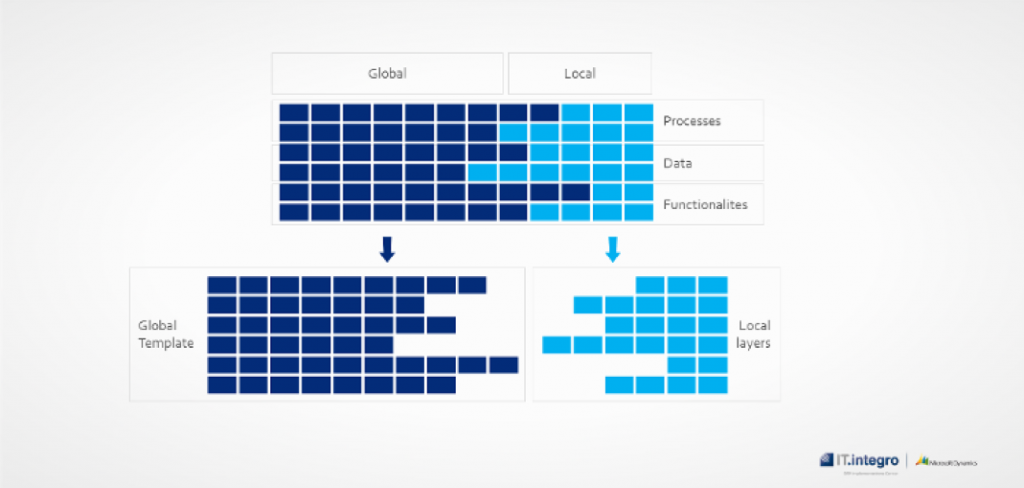
17 Jun Functionalities / customizations in consolidated ERP – Dynamics NAV
It is a common belief (especially among employees of global companies that we work with) that implementing one ERP system in all subsidiaries ensures a high level of standardization throughout the entire group. What we always try to do is to encourage our customers to take one step further. Implementing the same ERP system in all company locations is significant progress. However, standardization of business processes as well as data integrity are or immense importance too.

Functionality of one ERP system – common to all subsidiaries – can be prepared only if processes have been standardized.
Customizations in global Microsoft Dynamics NAV project
Functionalities or customizations of ERP system, such as Microsoft Dynamics NAV (Navision), may differ in various company locations even if their business profile is the same. There are three levels of standardization in this area:
- same PROFILE many PROCCESSES many CUSTOMIZATIONS – subsidiaries may have the same profile (for example bike production). But they do not receive general guidelines from the headquarters on how to do that. So everyone is free to choose the way to achieve that goal. As a result, they have different processes and with different processes they need different customizations.
- same PROFILE same PROCESS many CUSTOMIZATIONS – at some point the headquarters might say: “OK guys, location in Sweden has the best results (in bike production). We believe that their process is the best. So we want all of you to produce bikes in the same manner”. Then, the IT Managers in all locations ask their local partners to customize the local system. What is the result? Different partners “reinvent the wheel”. Everybody analyses the requirements, develops new modification and implements them. But they do itwithout any coordination. So you have the same processes, but the customizations differ.
- same PROFILEsame PROCESS same CUSTOMIZATION – the third approach is an easy one. Single team provides all your locations with the customization you require.
Customizations are the last step. First, you have to identify if your subsidiaries have the same profile. If their objectives are similar – try to standardize their processes. And, only after standardizing the processes – focus on the ERP system (customizations). You might be amazed at the number of similarities between locations. And, if they start working in a similar manner, you‘ll have the synergy effect. But that’s another story…
Three approaches (local / mixed / global) to project teams
The issue of functionality of an ERP system that is used by the group is strongly linked to project teams that are responsible for carrying out the implementation project. In our view, there are three approaches to project teams:
- LOCAL APPROACH (local partners, local project teams) – based on this approach, you (as a customer) are responsible for managing the project. You have to choose the local partner for each country. Then, you need to coordinate (to some point) the work of local project teams. Take into account that these teams do not know much of each other. It may be a good option if you havestrong in-house ERP (Dynamics NAV) competencies. Also, you must be sure that you are able to manage such a big project by yourself.
- MIXED APPROACH (global partner, local project teams) – based on that approach, your global partner is responsible for the global project. However, global partners themselves are nothing but merged or acquired local partners. Global partners may or may not communicate well with their local offices. You are no longer responsible for the coordination of the project. However, the global roll-out is still carried out bymany different local project teams. The teams are focused on local issues. So they lack the “global” view of your organization.
- GLOBAL APPROACH (global partner, global project team) – I would call that a “holistic approach”. You have a single partner and single project team that manages the project, and rolls-out the system to all countries. As far as I know, that approach is rare among partners. One of the reasons is that consultants simply do not want to travel that much. So the partners prefer to leave local issues to local partners. Another reason may be the lack of competencies to deal withlocal law/accounting issues.
Benefits of “holistic” approach
- Knowledge curve – the single project team learns much about your organization during roll-outs. So after several projects the average cost of roll-out decreases dramatically.
- Team of advisors who have unique knowledge about your organization – the limited number of consultants who are frequently visiting your locations can provide you with specific information about your company (both from local and global perspective).
- House-cleaning – the project team often finds good processes or business practises during roll-out in particular locations. These processes can be “transferred” to other locations, during next roll-outs. After all, roll-out is a good time to introduce changes in the organization.
- Global focus – the responsibility matters here. Each local project team is responsible for particular location(s). So it is locally focused. The global project team is responsible for the global roll-out in all locations. So it thinks about the organization as a whole.
Conclusions?
First, you have to figure out your goal – regarding functionality (customization). Is that a deeper standardization and consolidation in your global company? Or, you just want to leave your subsidiaries independent and very much different from each other. These are the questions that have to be answered before you will start developing a Core (Global ERP Template) for your subsidiaries. That is why, in case of global ERP projects, we always start with the Strategy Phase (as a first phase in our “global ERP methodology”). The Strategy Phase is a good time to discuss all of these “pre-ERP” topics.





